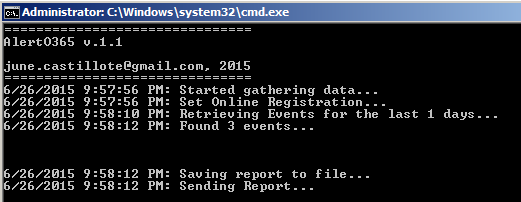Tool Overview
Sample Report
AlertO365 1.2 - https://github.com/junecastillote/AlertO365
Note: Download contains source code. If you want to just get the binary output and associated files listed in "Files and Folders" section above, just go to the "bin/Release" folder.
The AlertO365 Tool provides a mechanism to check the Office 365 Service Status and Events programmatically eliminating the need to logon to the Office 365 Portal manually. This tool utilize the “Office 365 Service Communications API” as provided by Microsoft.
Reference: https://msdn.microsoft.com/en-us/library/office/dn776043.aspx
The Package
Files and Folders
Name
|
Type
|
Description
|
AlertO365.exe
|
File
|
Main executable (no parameter required)
|
AlertO365.exe.config
|
File
|
Contain configuration values used by the tool (XML format)
|
microsoft.exchange.servicestatus.tenantcommunications.data.dll
|
File
|
Office 365 Communications API
|
report
|
Folder
|
First Sub-Folder
Contains the HTML reports
|
images
|
Folder
|
Sub-Folder of the Report Folder
|
Logo1.png
|
File
|
First Logo in the report
|
Logo2.png
|
File
|
Second Logo in the report
|
Install and Configure
Installation
To use this tool, no special install utility is needed. Just extract/copy the package to any location on the computer/server.
In this example, the tool is extracted and placed under the C:\ drive
 |
| Image 1. Folder Structure |
Configuration
The configuration file is AlertO365.exe.config, this is in XML format and can be edited using a normal text editor like Notepad.
Fields and Values
ServiceURL – No need to change this. This is a constant value provided by Microsoft in their API documentation
DomainNames – The Tenant Domain to be checked (enter only one domain)
UserName – Username used to authenticate to the Tenant Domain
Password – Password for the Tenant Domain credential
IsAOBO – No need to change this. The function related to this value is not (yet) implemented.
PastDays – Number of days with which the tool would query events for (i.e 1 for the past 1 day)
SenderAddress – Sender address of the email report
RecipientAddress – Recipient addresses of the email report. Separate with comma (,) for multiple recipients
SMTPServer – IP address or resolvable name of the SMTP relay used for sending the email report
MailSubject – The String to be used as Message Subject and Report Title
Company – The company or domain name that will appear in the report
SendViaEmail – Yes or No indicates whether the HTML output will be sent via email or not.
Other Configuration Items
The package contains two images namely Logo1.png and Logo2.png. These images are located under “\report\images” folder. Upon creation of the report, these images will be embedded in the email representing the Client/Company we managed and HP. Before putting the tool in production use, make sure to replace the Logo1.png file with the appropriate logo image for the client/company being managed.
Sample Report
How to Use
This is a console-only application which is best executed using the command shell (or can also be double-click in explorer – not recommended).
Can also be executed by Scheduled Task if preferred to run at certain interval (Daily, Hourly, Monthly..)
This is a console-only application which is best executed using the command shell (or can also be double-click in explorer – not recommended).
Can also be executed by Scheduled Task if preferred to run at certain interval (Daily, Hourly, Monthly..)
 |
Image 4. Sample Tool Execution
|
Download and Source Code
AlertO365 1.2 - https://github.com/junecastillote/AlertO365
Note: Download contains source code. If you want to just get the binary output and associated files listed in "Files and Folders" section above, just go to the "bin/Release" folder.












